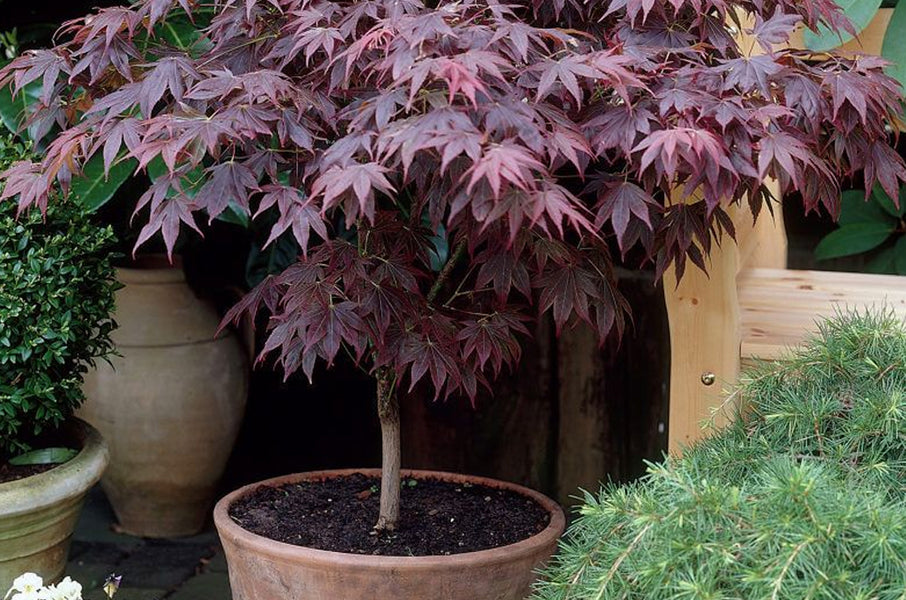As a gardener, I love having beautiful Japanese maples in pots on my patio during the warm seasons. But when winter arrives, extra care is needed to help these delicate trees survive the cold temperatures. Properly winterizing container maples until spring is crucial.
In this article, I’ll share my best tips for protecting potted Japanese maples during the winter based on my experience. Whether you need to shelter trees in an unheated garage or just mulch the pots in place, this guide will help you overwinter container maples successfully.
Why Winter Protection is Essential
Japanese maples are originally from Asia so their roots are adapted to warmer winters. When potted, the roots are more exposed than if planted in the ground. This vulnerability means they can easily be damaged by hard frosts below 10°F. Pots offer little insulation against freezing.
Even in slightly warmer zones, Japanese maple roots still feel the cold. Branches are also prone to desiccation from winter sun and wind. Taking steps to safeguard potted maples prevents dieback or even death of these beautiful but tender trees.
Watering Potted Maples During Dormancy
Proper moisture is key to winter care Here are tips on watering potted maples in winter
-
Before dormancy – Deeply soak trees in late fall before ground freezes. This hydrates them before dormancy.
-
During dormancy – Water sparingly, only if soil is fully dry. Goal is preventing roots from drying out, not stimulating growth.
-
Late winter – Monitor soil moisture closely in late winter. Lightly water as needed so pots don’t dry out as temperatures warm.
-
Indoor maples – Potted maples kept indoors likely need more frequent winter watering than outdoor ones
The key is to avoid overwatering which leads to root rot in cool weather. But don’t underwater either. Careful monitoring ensures the right balance.
Protecting Roots of Outdoor Potted Maples
For container maples left outdoors, take steps to protect the vulnerable roots:
-
Shelter pots in a protected spot away from wind. Grup pots to insulate roots.
-
Surround pots with mulch, leaves, straw or other organic matter to insulate roots from cold.
-
For extreme cold below 10°F, wrap potted maples with burlap or place pots in larger containers filled with mulch.
-
Move potted maples into an unheated garage or cellar if temperatures remain below 10°F for long periods.
Prevent drastic temperature fluctuations and freezing damage to roots with proper insulation methods.
Safeguarding Branches of Outdoor Maples
In addition to the roots, exposed branches need protection:
-
Avoid placing pots in sites with direct winter sun exposure which can burn branches.
-
If possible, move pots under eaves or cover with burlap to shield from drying winds.
-
Wrap trunks of young maples to prevent sunscald injury.
-
Prune out any dead branches in early spring to remove damage.
Shielding branches from the elements will maintain the graceful form of Japanese maples.
Transitioning Maples Back Outside
For potted maples kept in shelter, slowly reacclimate them outside in spring:
-
After last frost date, set pots in shade for a few days, gradually moving them into sun.
-
Watch for new growth and be ready to move pots back into shelter if a late cold snap occurs.
-
Once nighttime temperatures remain above freezing, maples can stay outside.
Prevent shock by slowly transitioning dormant indoor maples to outdoor spring conditions.
Fertilizing in Spring
Spring growth requires nutrients. Fertilize outdoor potted maples as weather warms:
-
Wait until soil thaws and new buds swell to fertilize. Never fertilize dormant trees.
-
Use a balanced organic granular fertilizer formulated for containers per label directions.
-
Or apply liquid kelp/fish emulsion fertilizer every 2-3 weeks according to label instructions.
-
Discontinue fertilizer by early summer to harden off trees for winter dormancy.
Avoid over-fertilizing which causes excessive late growth making trees prone to winter damage. Cease fertilizing by midsummer.
Pruning After Winter
In early spring, prune potted maples to:
-
Remove any dead branches damaged by winter.
-
Eliminate crossing branches to improve structure.
-
Control size if tree outgrew its pot.
Avoid heavy pruning that stimulates excessive new growth right before dormancy. Only do structural and maintenance pruning.

Winter care of your container grown Japanese maple tree
FAQ
What to do with potted Japanese maples in winter?
Buds and emerging leaves may die entirely. Pruning, watering, mulching, covering, and sheltering are all ways to protect Japanese maples in winter.Apr 28, 2023
Should I cover my Japanese maple from frost?
- Protect new growth: Young trees and those that have recently leafed out are most vulnerable to frost damage.
- Prevent dehydration: Frost can dehydrate the plant, and covering it helps to maintain moisture.
- Reduce stress: Frost can be stressful for the tree, and covering it can help minimize that stress.
Is it normal for Japanese maple to lose leaves in winter?
Japanese maples are deciduous trees, which means they do lose their leaves in the winter. During autumn, their leaves turn vibrant colours and then drop off as the tree goes dormant for the winter. Come spring, you’ll see fresh new leaves sprouting again.
Why is my potted Japanese maple dying?
- Extreme Cold : Japanese maples are generally hardy in USDA zones 5-8.
- Root Damage : If the tree’s roots are not adequately insulated by mulch or if the soil freezes deeply, the roots can suffer damage.
- Desiccation
- Poor Drainage
- Pests and Diseases
- Improper Pruning
- Lack of Acclimatization
- Environmental Stressors
